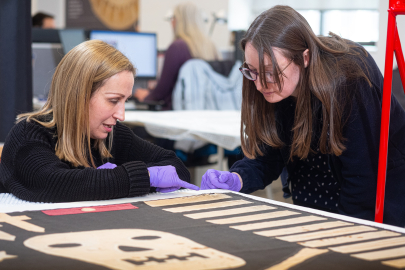Beware! Jolly Rogers on display
- View news filtered by: Victorian
- View news filtered by: Ships and Aircraft
- View news filtered by: HMS Alliance
- View news filtered by type: Press Release

The earliest known surviving example of a Royal Navy submarine Jolly Roger from HMS E54 flown over a century ago in 1916 joins the Museum’s newest acquisition from HMS Thorough 1943 in a new interpretation which opens for Easter at The Royal Navy Submarine Museum, Gosport. It tells the fascinating and little-known cultural history of the Jolly Roger flag.
Inspired by the imaginative and resourceful iconography hand-stitched by submariners during deployments, visitors can also create their very own Jolly Roger with a specially-created interactive that allows flags to be projected onto an adjoining wall.
Commonly, the Jolly Roger is thought of as a pirate flag, but Royal Navy submarines have been flying the flag for over 100 years in both defiance and in solidarity with the Silent Service. The tradition started in 1914 as Lieutenant Commander Max Horton, the captain of HMS E9, flew the flag as the boat returned after sinking the German warship SMS Hela. This was Horton’s defiant response to comments of Admiral Sir Arthur Wilson who likened submariners to pirates.
“Submarines are underhanded, unfair and damned unEnglish… treat all submarines as pirates in wartime… and hang all their crews.” Admiral of the Fleet, Sir Arthur Wilson, 1901
Whilst 17th century pirates raised their flags to frighten ships, submarine crews hoist theirs on return to base to show pride in the successes during a wartime patrol. Each flag is a unique visual record of the history of the boat as well as a striking piece of handcrafted folk art.
Alexandra Geary, Curator (Artefacts) from the National Museum of the Royal Navy explains:
“Each action a submarine carried out had its own symbol. These symbols would either be painted or sewn onto a bit of black material. A dagger, for example, would denote a secret mission; a bar signifies the sinking of an enemy merchant ship; a lighthouse that the boat was used as a navigation beacon and we even have a symbol of Popeye character “Eugene the Jeep” as a nod to the popular utility vehicle.
“Visitors are intrigued by our Jolly Rogers and enjoy deciphering their meanings. They give a fascinating insight into the often secret and mysterious world of the submariner under the waves and out of sight.”
By the Second World War, boat crews were officially issued with fabric, and their flying became almost universal within the service. Royal Navy submarines have continued this tradition; HMS Conqueror flew a Jolly Roger on her return from the Falklands Conflict in 1982 and HMS Otus flew their flag after returning from the Gulf War in 1991.
Photo credit: Solid Heritage